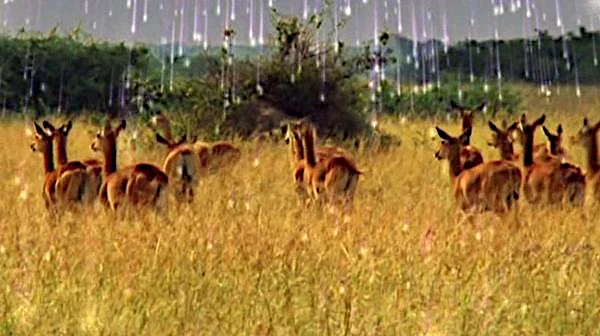
Above classic thunderstorms, in the high atmosphere, fleeting red flashes sometimes appear: these are sprites, or farfadets. These transient luminous events (TLEs) occur between 50 and 90 km in altitude, well above the stormy troposphere. They are caused by powerful electrical discharges induced by storms, but also influenced by energetic particles from space, cosmic rays.
Galactic cosmic rays are atomic nuclei accelerated to relativistic speeds by supernovae or other extreme events. When they penetrate the Earth's atmosphere, they interact with air nuclei and create showers of secondary particles. These muons, electrons, and positrons can locally increase the ionization of the mesosphere and facilitate the appearance of an electric field sufficient to initiate a sprite. In particular, relativistic electrons can lower the breakdown voltage in the rarefied air, making it possible to initiate a conductive channel several tens of kilometers long.
The precise mechanism linking cosmic rays and sprites is complex. It seems that the electric fields generated by positive lightning strikes on the ground (positive cloud-to-ground strokes) play a fundamental role, triggering an upward quasi-electrostatic wave that interacts with the ionized layers. Cosmic rays are therefore not the direct cause, but can act as catalytic triggers. Some experiments, such as those of the TARANIS satellite (CNES, 2020), aimed to unravel these fine interactions. Unfortunately, the mission was lost shortly after its launch, and many questions remain open.
Sprites are not just visual curiosities. Their study reveals complex dynamics in the Earth's upper atmosphere, influenced by both local meteorology and astrophysical processes. Moreover, the energy they release (up to several hundred megajoules) can play a role in the chemistry of the mesosphere, particularly in the formation of radicals such as NOx or O3. Finally, sprites could also exist in the atmospheres of other planets, such as Jupiter or Saturn, making them a universal phenomenon linked to intense electric fields in planetary atmospheres.
Cosmic rays, primarily composed of protons and heavy nuclei accelerated to relativistic speeds, interact with the Earth's atmosphere to produce secondary particles such as muons, neutrons, or electrons. These particles sometimes pass through the biosphere and reach living cells. Although their flux is low on the Earth's surface (~1 particle/cm²/minute), their high energy allows them to induce damage at the DNA level.
When a cosmic ray or a secondary particle passes through a cell, it can cause a single or double-strand break in DNA. If these lesions are not properly repaired, they can lead to point mutations, chromosomal rearrangements, or deletions. This random mechanism can sometimes induce an **advantageous mutation**, but more often, it results in a loss of cell viability or carcinogenesis.
The International Space Station (ISS), orbiting at an altitude of about 400 km, periodically flies over very active tropical storm zones. This altitude allows astronauts and onboard instruments to observe sprites from above or laterally, through the mesosphere. Unlike ground-based observers, limited by cloud cover and viewing angle, the ISS benefits from a clear sky and lateral visibility over hundreds of kilometers.
Installed in 2018 on the Columbus module, the European instrument ASIM (Atmosphere-Space Interactions Monitor) is dedicated to observing transient luminous phenomena (TLE). It combines fast cameras, X-ray/gamma ray detectors, and sensitive photometers. Thanks to ASIM, researchers have obtained high-resolution sequences of sprites, ELVES, and blue jets, allowing them to study their fine dynamics and emission spectrum in the near UV and visible.
From space, sprites reveal themselves as complex structures several tens of kilometers long, often organized into parallel or branched filaments, resembling inverted roots or carrots. Their red light, mainly from the excitation of N2, appears for a few milliseconds. Spectroscopic data also show the presence of emission lines related to molecular dissociation and ionic recombination.
The ISS has confirmed that the upper atmosphere is far from calm. Not only are sprites observed, but also phenomena such as ELVES (luminous rings 300 km in diameter created by the electromagnetic pulses of lightning) or blue jets, these blue plasma jets rising up to 50 km in altitude. These observations reveal complex interactions between storm electricity, electromagnetic fields, and cosmic particles.
The data collected from the ISS contribute to a new understanding of atmospheric remote sensing. Sprites thus become a natural probe of the ionization of the upper atmosphere. They offer a point of convergence between Earth sciences and space sciences, in a transdisciplinary perspective combining meteorology, plasma physics, optics, and particle astrophysics.
| Phenomenon | Typical Altitude | Duration | Origin |
|---|---|---|---|
| Classic Lightning | 0 to 10 km | 10-3 to 10-1 s | Electrical charge of clouds |
| Sprite | 50 to 90 km | 1 to 10 ms | Post-discharge fields + cosmic rays |
| Primary Cosmic Ray | Outside the atmosphere | > 106 years (since their emission) | Supernova, pulsars, black holes |
Sources: Neubert et al. (2008), Journal of Geophysical Research – Sprites, ELVES and other transient luminous events , ESA – Catalogue of ASIM observations , Dwyer & Uman (2014), Space Science Reviews – Physics of Lightning , arXiv:2304.08934 – High-energy particle influence on atmospheric discharges .